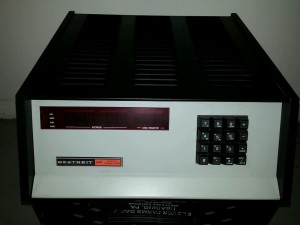
Heathkit was a long established electronics retailer, specializing in build-it-yourself electronic kits. In the wake of Altair’s original move to create a home computer for consumers, Heathkit believed they, too, could capitalize on the homebrew personal computer market. The result was the Heathkit H8 computer, introduced in July 1977. The H8 is similar to other S100 class computers in the sense that it used an Intel 8080 CPU, had a backplane expansion bus, and CP/M was commonly used on it, but the similarities ended there. Heathkit’s engineers noted the need to correct some major flaws in the S100 bus design, like having the +5 volt and ground pins right beside each other. Uncorrected, it was possible to short the power supply if a card was inserted crooked or a piece of metal dropped in the S100 slot at the right position. After all, this was the 70’s. You can’t have one of those low hanging disco chains getting in the works and shorting things out when bending over to insert an S100 card.
Heathkit’s solution to the S100 bus issues was to cut the S100 bus by half and create a 50-pin bus called the “Benton Harbor Bus”, named for the town in which Heathkit was located, Benton Harbor, Michigan. Ten “Benton Harbor” bus slots were implemented in the H8 design. The front panel itself was actually inserted into the first slot, making the H8 an almost completely modular computer. Because of the separate CPU board, nothing couldn’t technically stop a third party company from creating a new front panel assembly which becomes a plug-in replacement for the original H8 panel.
Consumers bought the H8 as a kit for $375, and like any other Heathkit product, received a well documented set of assembly instructions. But unlike a typical Heathkit product, the kit wasn’t a complete puzzle of loose parts to solder together. The owner assembled the power supply, front panel, and case, which required some soldering of electronic components. The CPU itself was inserted into one of the slots and came as a fully-tested pre-assembled board.
The finished computer was basically an idle running CPU since the kit did NOT include any RAM. The owner was expected to buy at least one RAM card. Since the bus system was somewhat proprietary, the $140 H8-1 4K RAM board was the only choice, but that board was needed if the user was to get any usefulness out of the computer. Programming the H8 was similar to the single board computers like the KIM-1, or those having an LED character display and numeric keypad for entry. There was only a 16 button keypad for the front of the H8 computer in which the user entered CPU commands directly in OCTAL format.
Octal is a rather obscure mode of data encoding. The Altair and IMSAI used binary value representation with a series of single LEDs on their control panels. Users would flip switches to create the binary numbers to interact with the computer. Computers like the KIM-1 used Hexadecimal values, requiring 8-bit input in the form of two characters consisting of the digits 0-9 plus the letters A-F. CPU commands were entered with values like 80, A8, FF, etc. OCTAL was a number set that was limited to the digits 0-7, so entering any one of the 8-bit values into a memory location required three number presses, instead of two.
| Numerical representation of different number systems | |||||
| Decimal | Binary | Octal | HEX | Split-Octal | |
| 5 | 00000101 | 5 | 05 | 0 | 5 |
| 35 | 00100011 | 43 | 23 | 0 | 43 |
| 180 | 10110100 | 264 | B4 | 0 | 264 |
| 255 | 11111111 | 377 | FF | 0 | 377 |
| 1000 | 1111101000 | 1750 | 3E8 | 3 | 350 |
The H8 display even had three sets of three 7-segment LED displays for output. This was arranged as “split-octal”, where the entire memory address range was broken down into two octal numbers. Rather confusing at the time and even more so today. However, if the $110 H8-5 Serial and Cassette interface board was purchased, then programs could at least be loaded from external storage sources, saving wear and tear on the keypad and minimizing the need to remember OCTAL based CPU commands.
In order to get a truly interactive home computer experience, all that was needed was a terminal display. The $530 H9 terminal was also available from Heathkit to complete the experience. Fully decked out H8 systems were also available from Heathkit as combination packages, saving the consumer a few hundred dollars over buying all the parts separately. This basically set the price of the H8 to about $1300 if it was to be compared to a desktop computing solution we are used to today with a CPU, monitor, and storage capabilities.
